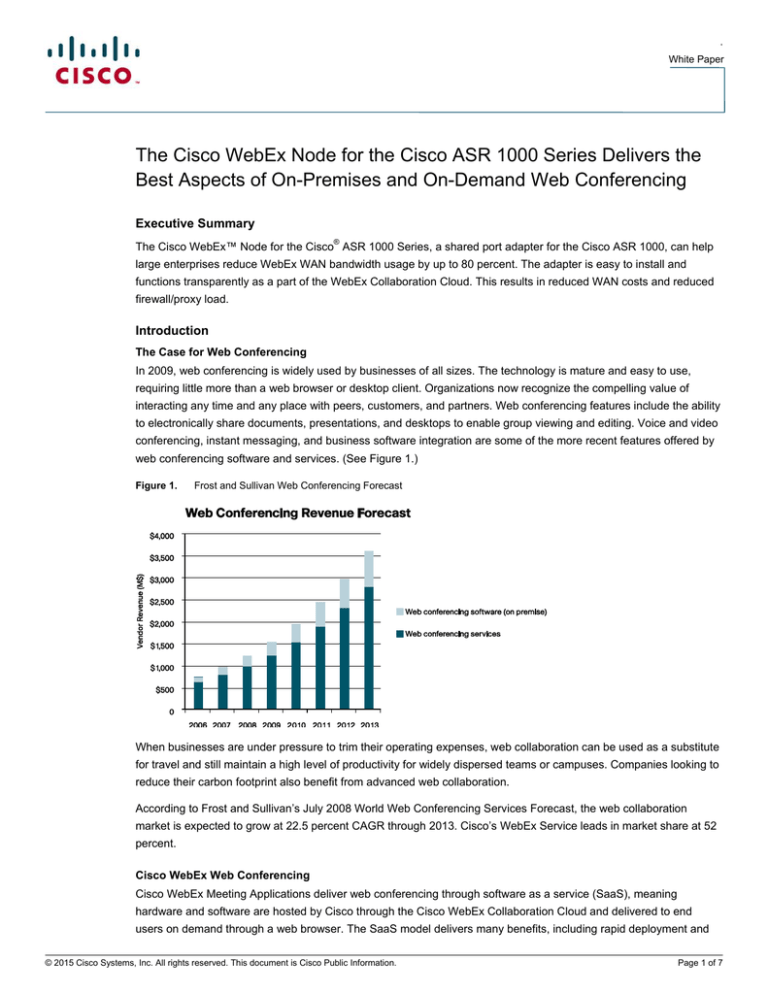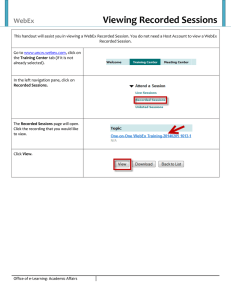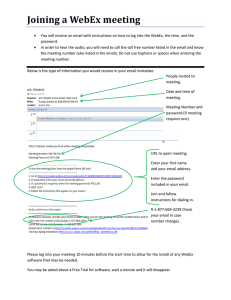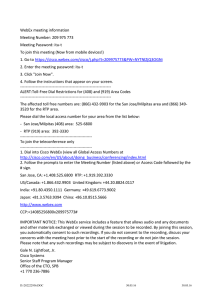
.
White Paper
The Cisco WebEx Node for the Cisco ASR 1000 Series Delivers the
Best Aspects of On-Premises and On-Demand Web Conferencing
Executive Summary
The Cisco WebEx™ Node for the Cisco® ASR 1000 Series, a shared port adapter for the Cisco ASR 1000, can help
large enterprises reduce WebEx WAN bandwidth usage by up to 80 percent. The adapter is easy to install and
functions transparently as a part of the WebEx Collaboration Cloud. This results in reduced WAN costs and reduced
firewall/proxy load.
Introduction
The Case for Web Conferencing
In 2009, web conferencing is widely used by businesses of all sizes. The technology is mature and easy to use,
requiring little more than a web browser or desktop client. Organizations now recognize the compelling value of
interacting any time and any place with peers, customers, and partners. Web conferencing features include the ability
to electronically share documents, presentations, and desktops to enable group viewing and editing. Voice and video
conferencing, instant messaging, and business software integration are some of the more recent features offered by
web conferencing software and services. (See Figure 1.)
Figure 1.
Frost and Sullivan Web Conferencing Forecast
When businesses are under pressure to trim their operating expenses, web collaboration can be used as a substitute
for travel and still maintain a high level of productivity for widely dispersed teams or campuses. Companies looking to
reduce their carbon footprint also benefit from advanced web collaboration.
According to Frost and Sullivan’s July 2008 World Web Conferencing Services Forecast, the web collaboration
market is expected to grow at 22.5 percent CAGR through 2013. Cisco’s WebEx Service leads in market share at 52
percent.
Cisco WebEx Web Conferencing
Cisco WebEx Meeting Applications deliver web conferencing through software as a service (SaaS), meaning
hardware and software are hosted by Cisco through the Cisco WebEx Collaboration Cloud and delivered to end
users on demand through a web browser. The SaaS model delivers many benefits, including rapid deployment and
© 2015 Cisco Systems, Inc. All rights reserved. This document is Cisco Public Information.
Page 1 of 7
White Paper
global scaling, low cost of overhead and maintenance, and immediate access to the most up-to-date features and
capabilities.
A tradeoff to these benefits is that enterprise WAN bandwidth requirements are increased, especially in a large
campus environment with wide-scale adoption of web conferencing. While the WAN bandwidth expense is
outweighed by the IT department savings of SaaS, reducing those demands can lead to significant enhancements in
web conferencing performance and allow that bandwidth to be used for other mission-critical business applications.
Business Case for the Optimum Web Conferencing Solution: Optimizing WebEx SaaS Web
Conferencing with a Simple Premises-Based Extension
A hybrid solution of WebEx hosted web conferencing with a premises-based solution promises to delver the best of
both worlds of on demand and on premises and to reduce WAN bandwidth costs and firewall load.
The Cisco WebEx Node for the ASR 1000 Series is designed to be such a hybrid solution. Technology details are
explained below.
Internal Meetings: By the Numbers
As web conferencing has become a standard business communication means such as with instant messaging and
phone conferencing, it inevitably means that many meetings will occur behind the corporate firewall. With a pure ondemand web conferencing service, these internal meetings will create sessions that traverse the firewall and add to
WAN bandwidth requirements. A hybrid solution will eliminate the need for many of these meeting streams to cross
the WAN and firewall boundary, but how much?
A good rule of thumb for very large enterprises is that 75% of meetings are internal while 25% are external. This
indicates that many WebEx customers would benefit from the WebEx Node for the ASR 1000. However, each
customer should assess their own WebEx meeting traffic patterns. In some cases, such as when WebEx is used
heavily for training or events, meeting traffic can be biased toward external usage.
Hybrid Model: Hypothetical Business Case
Table 1 shows a hypothetical business case comparing a pure on-demand solution to a hybrid solution using the
WebEx Node for the ASR 1000 Series. The business case assumes that the enterprise is using meeting, voice, and
video capabilities of WebEx.
The business case assumes that a large enterprise with a significant campus location has about 2500 peak
attendees with 75 percent of those attendees internal to the campus and behind the firewall. The ratio of external to
internal attendees was determined by a Cisco WebEx analysis of meeting traffic.
© 2015 Cisco Systems, Inc. All rights reserved. This document is Cisco Public Information.
Page 2 of 7
White Paper
Table 1.
Hypothetical Business Case
Without WebEx Node
With WebEx Node
Meeting Assumptions
Peak concurrent meetings
625
625
Peak attendees
2500
2500
Internal vs. External mix
75%
75%
Peak Internal Attendees
1875
1875
225
82
WAN Bandwidth Usage (MB)
WAN Bandwidth Reduction
64%
Cost Assumptions
Required Quantity of WebEx Nodes
Meeting
0
4
VoIP/Video
0
5
Price Per WebEx Node (K$)
$0.00
$35.00
Total WebEx Node Price (K$)
$0.00
$315.00
Total ASR 1000 Bill of Material (BOM)
$0.00
$182.00
Typical discount
$0.00
50.00%
Total Estimated Capital Costs (K$)
$0.00
$248.50
5
2
$17.50
$7.00
DS3s Required
Monthly DS3 Costs (K$)
WAN Bandwidth Cost Reduction
60%
Payback (months)
23.7
With the assumptions in Table 1, the WebEx Node for the ASR 1000 Series will reduce WAN bandwidth by 64
percent and WAN costs by 60 percent, and the payback period for the investment of $248,500 of equipment
would be 23.7 months.
If the enterprise plans to grow WebEx usage, the WebEx node for the ASR 1000 Series can also have a positive
effect on bandwidth reduction.
In a scenario with traffic patterns similar to the case above except where only meeting traffic is generated (see Figure
2), the enterprise can grow usage to 1625 concurrent meetings and keep bandwidth usage below 50 Mbps, a savings
of 81 percent over a purely on-demand solution.
© 2015 Cisco Systems, Inc. All rights reserved. This document is Cisco Public Information.
Page 3 of 7
White Paper
Figure 2.
WAN Bandwidth Usage – Meeting Traffic Only
Alternatively, if the enterprise is growing and uses the voice, video, and meeting capabilities of WebEx, using the
WebEx Node for the ASR 1000 Series can result in bandwidth savings of approximately 64 percent. At 1625
concurrent meetings an accelerated solution will generate a peak traffic load of about 211 Mbps vs. a nonaccelerated load of about 585 Mbps. (See Figure 3.)
Figure 3.
WAN Bandwidth Usage – Multimedia Traffic
A Hybrid Solution: The Cisco WebEx Node for the ASR 1000 Series plus WebEx Meeting
Applications
WebEx Node for the ASR 1000 Series: What Is It?
The WebEx Node for the ASR 1000 Series is a shared port adapter (hardware module) for the ASR 1000 that
integrates transparently with the Cisco WebEx Collaboration Cloud network. The adapter runs WebEx software that
enables it to act like a private extension of the WebEx hosted service. It’s like having a self-managing WebEx data
center on campus. (See Figure 4.)
© 2015 Cisco Systems, Inc. All rights reserved. This document is Cisco Public Information.
Page 4 of 7
White Paper
Figure 4.
ASR 1000 Series plus WebEx Node
Software that runs on the WebEx Node for the ASR 1000 Series is based on proven WebEx Collaboration Cloud
software components that are core to meeting collaboration and voice and video conferencing.
Architecturally, the WebEx Collaboration Cloud manages the adapter as just another part of the cloud whose capacity
is dedicated to a private enterprise. Together, the WebEx Collaboration Cloud and the WebEx Node for the ASR
1000 Series form a high-performance distributed collaboration solution.
A secure connection between the module and the WebEx Collaboration Cloud is established using Secure Sockets
Layer (SSL) encryption. All signaling collaboration data and multimedia information is hidden from the Internet using
an SSL tunnel.
Collaboration server resources on the module, which are available only to the enterprise, are automatically managed
and allocated by intelligence in the WebEx Collaboration Cloud. The same WebEx operational support system
continues to help the enterprise manage its WebEx service, which includes the on-premises resources contained in
the WebEx Node for the ASR 1000 Series.
In addition, capacity is managed automatically. If the WebEx Node for the ASR 1000 Series reaches a capacity
constraint, the WebEx meeting service will automatically overflow meeting participants to meeting zone resources on
the network.
The ASR 1000 is an advanced Cisco services router designed specifically to handle services above and beyond its
standard duties as a router. In a WAN gateway scenario, for example, the ASR 1000 can be deployed as a standard
router but also a firewall with up to 20G of throughput. Cisco ASR 1000 Series routers offer service providers and
enterprises industry-leading performance, service capabilities, reliability, and efficiencies in a compact form factor.
Using the innovative Cisco Flow processor, current and future services can be instantly turned on to operate at line
rate without compromising network performance or availability.
Cisco WebEx Node for the ASR 1000 Series: How Does It Work?
Without a WebEx Node for the ASR 1000 Series, all meeting connections from WebEx clients connect with the
WebZone in the WebEx Collaboration Cloud, which resides in a WebEx data center. This means that for a large
enterprise, there may be many connections traversing the firewall and utilizing WAN bandwidth. In our business case
above we assumed that there were 1980 maximum peak attendees. A simplified diagram of this scenario is shown in
Figure 5, with three on-premises meeting participants for illustration purposes.
© 2015 Cisco Systems, Inc. All rights reserved. This document is Cisco Public Information.
Page 5 of 7
White Paper
Figure 5.
Scenario Without WebEx Node for the ASR 1000 Series
When the WebEx Node and the ASR 1000 are installed on premises in the enterprise, internal meeting participants
can join the meeting zone (or collaboration server) that resides on enterprise side of the WAN demarcation point
inside the firewall. This reduces WAN bandwidth and load on the corporate firewall. See Figure 6.
Figure 6.
Scenario with WebEx Node for the ASR 1000 Series
As you can see in Figure 6, internal meeting attendees’ collaboration data is switched on site and therefore does not
cross the firewall. Meeting participants from the outside a switched through the WebEx data center and connected to
the meeting using secure SSL connections.
© 2015 Cisco Systems, Inc. All rights reserved. This document is Cisco Public Information.
Page 6 of 7
White Paper
Conclusion
The Cisco ASR 1000; WebEx Node; and hybrid on-premises, on-demand architecture deliver an optimized solution
for midsized to large enterprises and provides:
●
The highest level of performance for all attendees
◦ Attendees connect to the closest node on site or off site
◦ Heavy lifting (meeting zone) is done as close as to the attendee as possible
◦ Lowest possible latency
●
Global coverage
◦ The WebEx Collaboration Cloud on-demand platform is used for attendees outside the firewall
●
Expensive control, administration, and enhanced services remain in the WebEx Collaboration Cloud hosted
platform
◦ Billing and reporting
◦ Recording
◦ Monitoring
●
Low customer deployment and maintenance costs
◦ No dedicated servers or appliances
◦ No configuration
◦ No admin or maintenance overhead for the enterprise
◦ Service operates transparently
Additional Resources
Cisco WebEx
http://www.WebEx.com/
WebEx Meeting Applications: Enterprise Grade Performance
http://www.webex.com/enterprise/web-meeting-applications/enterprise-grade-performance.html
ASR 1000 Product Information
http://www.cisco.com/en/US/products/ps9343/index.html
Printed in USA
© 2015 Cisco Systems, Inc. All rights reserved. This document is Cisco Public Information.
C11-532266-01
09/15
Page 7 of 7




